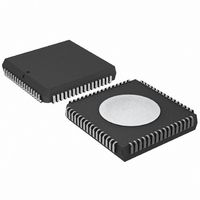P80C592FFA/00,512 NXP Semiconductors, P80C592FFA/00,512 Datasheet - Page 61

P80C592FFA/00,512
Manufacturer Part Number
P80C592FFA/00,512
Description
IC 80C51 MCU 8BIT ROMLESS 68PLCC
Manufacturer
NXP Semiconductors
Series
80Cr
Datasheet
1.P80C592FFA00512.pdf
(108 pages)
Specifications of P80C592FFA/00,512
Program Memory Type
ROMless
Package / Case
68-PLCC
Core Processor
8051
Core Size
8-Bit
Speed
16MHz
Connectivity
CAN, EBI/EMI, UART/USART
Peripherals
DMA, POR, PWM, WDT
Number Of I /o
48
Ram Size
512 x 8
Voltage - Supply (vcc/vdd)
4.5 V ~ 5.5 V
Data Converters
A/D 8x10b
Oscillator Type
Internal
Operating Temperature
-40°C ~ 85°C
Processor Series
P80C5x
Core
80C51
Data Bus Width
8 bit
Data Ram Size
512 B
Interface Type
CAN/UART
Maximum Clock Frequency
16 MHz
Number Of Programmable I/os
40
Number Of Timers
3
Maximum Operating Temperature
+ 85 C
Mounting Style
SMD/SMT
3rd Party Development Tools
PK51, CA51, A51, ULINK2
Minimum Operating Temperature
- 40 C
On-chip Adc
8-ch x 10-bit
Cpu Family
80C
Device Core
80C51
Device Core Size
8b
Frequency (max)
16MHz
Program Memory Size
Not Required
Total Internal Ram Size
512Byte
# I/os (max)
40
Number Of Timers - General Purpose
3
Operating Supply Voltage (typ)
5V
Operating Supply Voltage (max)
5.5V
Operating Supply Voltage (min)
4.5V
Instruction Set Architecture
CISC
Operating Temp Range
-40C to 85C
Operating Temperature Classification
Industrial
Mounting
Surface Mount
Pin Count
68
Package Type
PLCC
Lead Free Status / RoHS Status
Lead free / RoHS Compliant
Eeprom Size
-
Program Memory Size
-
Lead Free Status / Rohs Status
Compliant
Other names
568-1241-5
935086530512
P80C592FFAA
935086530512
P80C592FFAA
Available stocks
Company
Part Number
Manufacturer
Quantity
Price
Company:
Part Number:
P80C592FFA/00,512
Manufacturer:
ON
Quantity:
300
Company:
Part Number:
P80C592FFA/00,512
Manufacturer:
NXP Semiconductors
Quantity:
10 000
Philips Semiconductors
13.6.8.3
To ensure the validity of a transmitted message all
receivers perform a CRC check. Therefore, in addition to
the (destuffed) information digits (Start-Of-Frame up to
Data Field), every message includes some control digits
(CRC Sequence; generated by the transmitting
CAN-controller of the respective message) used for error
detection.
The code used by all CAN-controllers is a (shortened)
BCH code, extended by a parity check and has the
following attributes:
As a result, ‘(d 1)’ random errors are detectable (some
exceptions exist).
The CRC Sequence is determined (calculated) by the
following procedure:
1. The destuffed bit stream consisting of Start-Of-Frame
2. This polynomial is divided (modulo-2) by the following
3. The remainder of this polynomial division is the
Burst errors are detected up to a length of 15
least d = 6) are not detected with a residual error
probability of
13.6.8.4
Form Errors result from violations of the fixed form of the
following bit fields:
During the transmission of these bit fields an error
condition is recognized if a dominant bit level instead of a
recessive one is detected.
1996 Jun 27
degree of f(x) . Multiple errors (number of disturbed bits at
127 bits as maximum length of the code.
112 bits as maximum number of information digits
(max. 83 bits are used by the CAN-controller).
Length of the CRC Sequence amounts to 15 bits.
Hamming distance d = 6.
CRC Delimiter
Acknowledge Delimiter
End-Of-Frame
Error Delimiter
Overload Delimiter.
8-bit microcontroller with on-chip CAN
up to the Data Field (if present) is interpreted as
polynomial with coefficients 0 or 1.
generator polynomial, which includes a parity check:
(x + 1) = 1100010110011001 B.
CRC Sequence.
f x ( )
=
CRC Error
Form Error
x
2
14
–
15
+
x
9
3 10
+
x
8
+
–
5
x
6
by CRC check only.
+
x
5
+
x
4
+
x
2
+ +
x
1
61
13.6.8.5
This is detected by a transmitter whenever it does not
monitor a dominant bit during the Acknowledge Slot.
13.6.8.6
The detection of an error is signalled by transmitting an
Error Flag. An Active Error Flag causes a Stuff Error, a Bit
Error or a Form Error at all other CAN-controllers.
13.6.8.7
Errors which occur at all CAN-controllers (global errors)
are 100% detected. For local errors, i.e. for errors
occurring at some CAN-controllers only, the shortened
BCH code, extended by a parity check, has the following
error detection capabilities:
13.6.9
13.6.9.1
A CAN-controller which has too many unsuccessful
transmissions, relative to the number of successful
transmissions, will enter the Bus-OFF state. It remains in
this state, neither receiving nor transmitting messages
until the Reset Request bit is set LOW (absent) and both
Error Counters set to 0 (see Section 13.6.10).
13.6.9.2
A CAN-controller which has received a valid message
correctly, indicates this to the transmitter by transmitting a
dominant bit level on the bus during the Acknowledge Slot,
independent of accepting or rejecting the message.
13.6.9.3
An error-active CAN-controller in its normal operating state
is able to receive and to transmit normally and also to
transmit an Active Error Flag (see Section 13.6.10).
Up to five single Bit Errors are 100% detected, even if
they are distributed randomly within the code.
All single Bit Errors are detected if their total number
(within the code) is odd.
The residual error probability of the CRC check amounts
to (3
CRC check but also by other detection processes
described above the residual error probability is several
magnitudes less than (3
E
10
RROR CONFINEMENT DEFINITIONS
Acknowledgement Error
Error detection by an Error Flag from
another CAN-controller
Error Detection Capabilities
Bus-OFF
Acknowledge
Error-Active
5
). As an error may be detected not only by
10
5
).
Product specification
P8xC592















